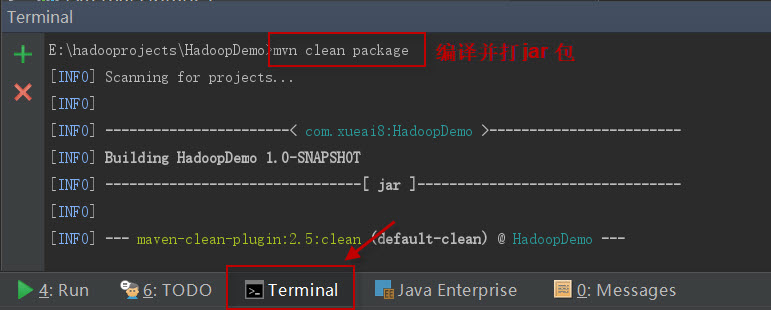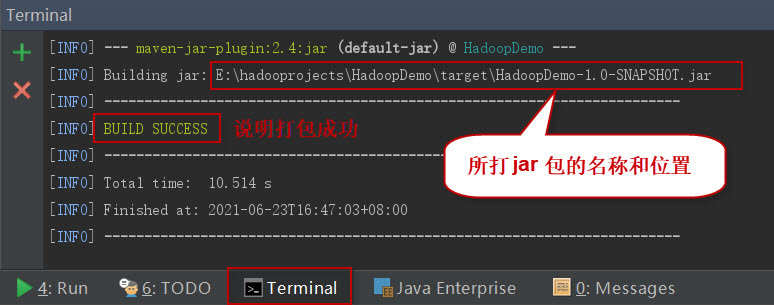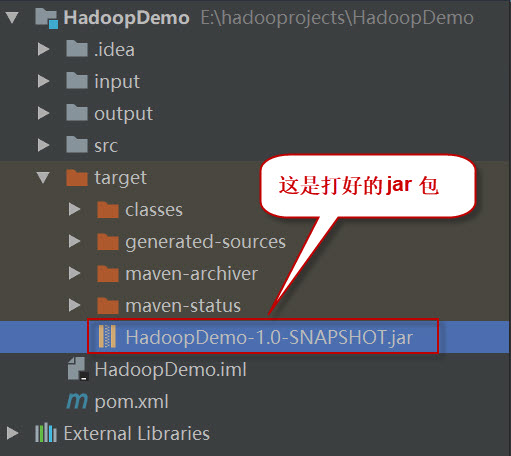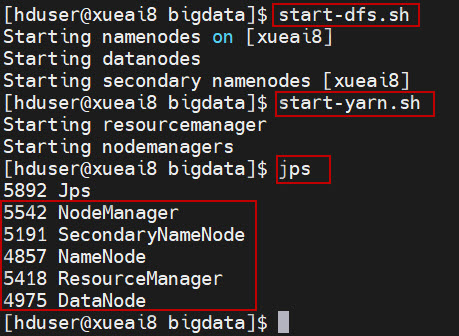MapReduce基础案例08-大数据排序
“数据排序”是许多实际任务执行时要完成的第一项工作,比如学生成绩评比、数据建立索引等。 这个实例和数据去重类似,都是先对原始数据进行初步处理,为进一步的数据操作打好基础。 下面就进入这个实例的MapReduce程序设计。
对输入文件中数据进行排序。输入文件中的每行内容均为一个数字,即一个数据。 要求在输出中每行有两个间隔的数字,其中,第一个代表原始数据在原始数据集中的位次,第二个代表原始数据。
样本数据文件 file1.txt。内容如下:
2 32 654 32 15 756 65223
样本数据文件 file2.txt。内容如下:
5956 22 650 92
样本数据文件 file3.txt。内容如下:
26 54 6
设计思路
这个实例仅仅要求对输入数据进行排序,而在MapReduce过程中本身就有排序,所以我们可以利用这个默认的排序,而不需要自己再实现具体的排序了。
但是在使用之前首先需要了解它的默认排序规则。它是按照key值进行排序的,如果key为封装int的IntWritable类型,那么MapReduce按照数字大小对key排序,如果key为封装为String的Text类型,那么MapReduce按照字典顺序对字符串排序。
了解了这个细节,我们就知道应该使用封装int的IntWritable型数据结构了。也就是在map中将读入的数据转化成IntWritable型,然后作为key值输出(value任意)。reduce拿到
一、创建Java Maven项目
Maven依赖:
<?xml version="1.0" encoding="UTF-8"?>
<project xmlns="http://maven.apache.org/POM/4.0.0"
xmlns:xsi="http://www.w3.org/2001/XMLSchema-instance"
xsi:schemaLocation="http://maven.apache.org/POM/4.0.0 http://maven.apache.org/xsd/maven-4.0.0.xsd">
<modelVersion>4.0.0</modelVersion>
<groupId>HadoopDemo</groupId>
<artifactId>com.xueai8</artifactId>
<version>1.0-SNAPSHOT</version>
<dependencies>
<!--hadoop依赖-->
<dependency>
<groupId>org.apache.hadoop</groupId>
<artifactId>hadoop-common</artifactId>
<version>3.3.1</version>
</dependency>
<!--hdfs文件系统依赖-->
<dependency>
<groupId>org.apache.hadoop</groupId>
<artifactId>hadoop-hdfs</artifactId>
<version>3.3.1</version>
</dependency>
<!--MapReduce相关的依赖-->
<dependency>
<groupId>org.apache.hadoop</groupId>
<artifactId>hadoop-mapreduce-client-core</artifactId>
<version>3.3.1</version>
</dependency>
<dependency>
<groupId>org.apache.hadoop</groupId>
<artifactId>hadoop-mapreduce-client-jobclient</artifactId>
<version>3.3.1</version>
</dependency>
<!--junit依赖-->
<dependency>
<groupId>junit</groupId>
<artifactId>junit</artifactId>
<version>4.12</version>
<scope>test</scope>
</dependency>
</dependencies>
<build>
<plugins>
<!--编译器插件用于编译拓扑-->
<plugin>
<groupId>org.apache.maven.plugins</groupId>
<!--指定maven编译的jdk版本和字符集,如果不指定,maven3默认用jdk 1.5 maven2默认用jdk1.3-->
<artifactId>maven-compiler-plugin</artifactId>
<configuration>
<source>1.8</source> <!-- 源代码使用的JDK版本 -->
<target>1.8</target> <!-- 需要生成的目标class文件的编译版本 -->
<encoding>UTF-8</encoding><!-- 字符集编码 -->
</configuration>
</plugin>
</plugins>
</build>
</project>
SortMapper.java:
package com.xueai8.sort;
import org.apache.hadoop.io.IntWritable;
import org.apache.hadoop.io.Text;
import org.apache.hadoop.mapreduce.Mapper;
import java.io.IOException;
/**
*
* 大数据排序
*/
public class SortMapper extends Mapper<Object,Text,IntWritable,IntWritable>{
private static IntWritable data = new IntWritable();
//实现map函数:将输入中的value化成IntWritable类型,作为输出的key
@Override
public void map(Object key, Text value, Context context) throws IOException,InterruptedException{
String line = value.toString();
data.set(Integer.parseInt(line));
context.write(data, new IntWritable(1));
}
}
SortReducer.java
package com.xueai8.sort;
import org.apache.hadoop.io.IntWritable;
import org.apache.hadoop.mapreduce.Reducer;
import java.io.IOException;
/**
*
* 大数据排序
*/
public class SortReducer extends Reducer<IntWritable,IntWritable,IntWritable,IntWritable> {
// 注意:linenum必须定义在此,并且是static静态类型的
private static IntWritable linenum = new IntWritable(1);
// 实现reduce函数
// 将输入中的key复制到输出数据的key上,
// 然后根据输入的value-list中元素的个数决定key的输出次数
// 用全局linenum来代表key的排名
@Override
public void reduce(IntWritable key, Iterable<IntWritable> values,Context context)
throws IOException,InterruptedException{
for(IntWritable val : values){
context.write(linenum, key);
linenum.set(linenum.get() + 1);
}
}
}
SortDriver.java:
package com.xueai8.sort;
import org.apache.hadoop.conf.Configuration;
import org.apache.hadoop.fs.Path;
import org.apache.hadoop.io.IntWritable;
import org.apache.hadoop.mapreduce.Job;
import org.apache.hadoop.mapreduce.lib.input.FileInputFormat;
import org.apache.hadoop.mapreduce.lib.output.FileOutputFormat;
import org.apache.hadoop.util.GenericOptionsParser;
/**
*
* 大数据排序
*/
public class SortDriver {
public static void main(String[] args) throws Exception{
Configuration conf = new Configuration();
String[] otherArgs = new GenericOptionsParser(conf, args).getRemainingArgs();
if (otherArgs.length != 2) {
System.err.println("用法: SortDriver <in> <out>");
System.exit(2);
}
Job job = Job.getInstance(conf, "Data Sort");
job.setJarByClass(SortDriver.class);
//设置Map和Reduce处理类
job.setMapperClass(SortMapper.class);
job.setReducerClass(SortReducer.class);
//设置输出类型
job.setOutputKeyClass(IntWritable.class);
job.setOutputValueClass(IntWritable.class);
//设置输入和输出目录
FileInputFormat.addInputPath(job, new Path(otherArgs[0]));
FileOutputFormat.setOutputPath(job, new Path(otherArgs[1]));
// 提交作业
System.exit(job.waitForCompletion(true) ? 0 : 1);
}
}
二、配置log4j
在src/main/resources目录下新增log4j的配置文件log4j.properties,内容如下:
log4j.rootLogger = info,stdout
### 输出信息到控制抬 ###
log4j.appender.stdout = org.apache.log4j.ConsoleAppender
log4j.appender.stdout.Target = System.out
log4j.appender.stdout.layout = org.apache.log4j.PatternLayout
log4j.appender.stdout.layout.ConversionPattern = [%-5p] %d{yyyy-MM-dd HH:mm:ss,SSS} method:%l%n%m%n
三、项目打包
打开IDEA下方的终端窗口terminal,执行"mvn clean package"打包命令,如下图所示:

如果一切正常,会提示打jar包成功。如下图所示:

这时查看项目结构,会看到多了一个target目录,打好的jar包就位于此目录下。如下图所示:

四、项目部署
请按以下步骤执行。
1、启动HDFS集群和YARN集群。在Linux终端窗口中,执行如下的脚本:
$ start-dfs.sh
$ start-yarn.sh
查看进程是否启动,集群运行是否正常。在Linux终端窗口中,执行如下的命令:
$ jps
这时应该能看到有如下5个进程正在运行,说明集群运行正常:
5542 NodeManager
5191 SecondaryNameNode
4857 NameNode
5418 ResourceManager
4975 DataNode

2、将数据文件sample.txt上传到HDFS的/data/mr/目录下。
$ hdfs dfs -mkdir -p /data/mr $ hdfs dfs -put file1.txt /data/mr/ $ hdfs dfs -put file2.txt /data/mr/ $ hdfs dfs -put file3.txt /data/mr/ $ hdfs dfs -ls /data/mr/
3、提交作业到Hadoop集群上运行。(如果jar包在Windows下,请先拷贝到Linux中。)
在终端窗口中,执行如下的作业提交命令:
$ hadoop jar com.xueai8-1.0-SNAPSHOT.jar com.xueai8.sort.SortDriver /data/mr /data/mr-output
4、查看输出结果。
在终端窗口中,执行如下的HDFS命令,查看输出结果:
$ hdfs dfs -ls /data/mr-output $ hdfs dfs -cat /data/mr-output/part-r-00000
可以得到类似下面这样的输出结果:
1 2 2 6 3 15 4 22 5 26 6 32 7 32 8 54 9 92 10 650 11 654 12 756 13 5956 14 65223
